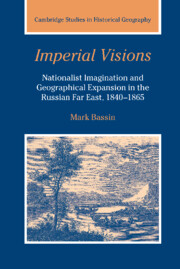 Imperial Visions
Imperial Visions Published online by Cambridge University Press: 06 July 2009
“A malignant ulcer”
At the end of the 1850s, amidst the excitement and optimism about the annexation of the Amur which we have been considering, a very different tone began to be heard in the discussion of the region and river. This was a tone not only of reservation, but even of incredulity in regard to the the dizzying vistas which were being depicted for the reading public of the country. It was not so much the acquisition as such of the far-eastern territories as such which was called into question – although this was something of an issue as well, as we will see – but rather the way in which the entire process was being handled, and in particular the careless and simple-minded exuberance with which the affair was being presented to the rest of the country. An officer who had taken part in establishing the first settlements on the Amur complained bitterly in a letter from Moscow back to Eastern Siberia about the “lies and boasting” and the “fallacious information” which newspapers and magazines in the nation's capital were disseminating about affairs in the Far East. Other critics expressed their consternation more publicly. In one of his earliest essays, the Siberian historian and ethnographer Nikolai Iadrintsev – a committed regionalist and sensitive in any event to the way Russians west of the Urals viewed his homeland – spoke mockingly about the promoters or “panegyrists” of the Amur.
To save this book to your Kindle, first ensure [email protected] is added to your Approved Personal Document E-mail List under your Personal Document Settings on the Manage Your Content and Devices page of your Amazon account. Then enter the ‘name’ part of your Kindle email address below. Find out more about saving to your Kindle.
Note you can select to save to either the @free.kindle.com or @kindle.com variations. ‘@free.kindle.com’ emails are free but can only be saved to your device when it is connected to wi-fi. ‘@kindle.com’ emails can be delivered even when you are not connected to wi-fi, but note that service fees apply.
Find out more about the Kindle Personal Document Service.
To save content items to your account, please confirm that you agree to abide by our usage policies. If this is the first time you use this feature, you will be asked to authorise Cambridge Core to connect with your account. Find out more about saving content to Dropbox.
To save content items to your account, please confirm that you agree to abide by our usage policies. If this is the first time you use this feature, you will be asked to authorise Cambridge Core to connect with your account. Find out more about saving content to Google Drive.